Nano aquariums: varieties, selection and design

The fashion for decorating residential and office premises with tanks with decorative aquatic inhabitants and plants is not slowing down. Therefore, for some aquarists, no less attractive containers have been invented, allowing them to keep fish and grow flora in small-sized analogs of the usual aquariums. Our article is devoted to nanoaquariums.
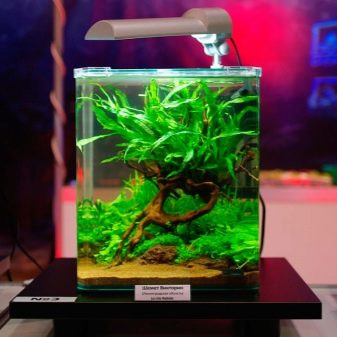

What it is?
Today, under the name "nanoaquarium", aquarists do not mean any separate type of tank for closed fish breeding, but a whole group of aquariums that stand out for their spaciousness, variety of shapes and other parameters.
A nano aquarium is a tank, the volume of which can vary from 5-30 liters, and can contain freshwater or marine flora and fauna. In accordance with this, a special group of aquatic inhabitants and plants is distinguished that are able to live, reproduce and grow in a small closed aquatic environment. Today, specialized stores sell certain varieties of fish, crustaceans and aquatic crops intended specifically for nanoaquariums.

Advantages and disadvantages
Such tanks, commonly used in residential, office and public spaces, stand out for their high decorative appeal. However, before purchasing such products, it is worthwhile to thoroughly study its strengths and weaknesses.
Let's look at the merits first.
- In light of its small volumes, compared to conventional aquariums, these varieties will not take up much space on a table, cabinet, windowsill or any other surface. This point will be especially relevant for rooms that do not stand out for their large area or for pieces of furniture on which, due to the specifics of their operation, there are many other necessary decorative or functional things.
- It will be much easier to care for nano aquariums. This feature is also directly related to the small capacity of the tank, in light of which it is these containers that are recommended to be purchased for novice aquarists and children.
- For such products, there is no need to buy a large number of plants, soil and inhabitants, which is associated with cost savings.
- It will be easier to create a specific design and layout.
- If desired, the nano aquarium can be easily moved or rearranged to another place in a room or place in another room. Such a moment with ordinary aquariums will cause a lot of difficulties.
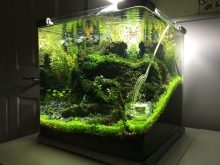
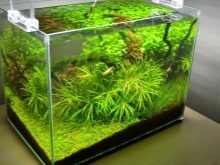

There are also disadvantages here:
- maintaining appropriate conditions in a small ecosystem will require certain knowledge, since the slightest deviations can lead to the death of all aquatic inhabitants and cultures;
- For more experienced aquarists, small aquatic ecosystems may not always be of interest;
- in order to maintain all parameters in the norm, it may be necessary to purchase specialized equipment, which is characterized by its high cost.

Shapes and sizes
Among the range of decorative aquariums, you can find models that differ from each other in shape and size. The most demanded are containers in the form of a cube.
Nanocubes can be of the following sizes:
- 10 l;
- 20 l;
- 30 l.



Also on sale there are rectangular aquariums with a panoramic front wall. Their volume can be 5, 10, 15 and 20 liters. Cylindrical aquariums come in a variety of sizes. The round nanocube stands out for its special attractiveness, the height of its walls varies within 15-20 centimeters.


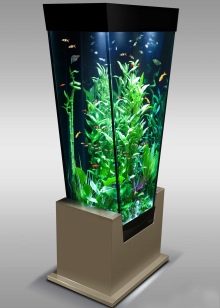
How to choose?
The shape and size of nanoaquariums are selected based on personal preferences and the availability of a free surface. In order to choose the right such decorative products, it is worth adhering to some recommendations.
- On sale there are containers made of ordinary durable glass, as well as products made of acrylic. The advantage in terms of operation and performance is on the side of the latter varieties. This is due to the high strength of raw materials.
- From the density of the material and the smoothness of the walls the ability of the container to maintain the temperature of the water will also depend. In addition, the rate of algae growth is also determined by the quality of the surface. In this case, round and acrylic aquariums stand out for their greater practicality.
- As for the forms, then the most convenient for operation will be a small rectangular nano-aquarium or a square container.
- When decorating an aquarium with decorative films, which are usually used for back walls, it will be more comfortable to work with straight and level surfaces. It will be much more difficult to stick such material on round walls.
- An important nuance regarding the choice of a miniature aquarium, completing it with the necessary equipment is considered. It is most correct to purchase models with a set of necessary filters, aerators, lamps and other important components.
- If the aquarium is planned to be placed using brackets or other fasteners, then you should understand that it will be much heavier with water and aquatic inhabitants. Therefore, it is important to anticipate the load in advance.
- You should first consider the choice of inhabitants, as well as the compatibility of one species with another.You should also additionally consider the issue of the design theme, so that all components are harmoniously combined with each other.



How to equip?
The design of the nano-aquarium provides for the placement of additional devices in it, which can maintain normal all the necessary parameters that are important for the life of aquatic inhabitants and cultures.
To start an aquarium, its owner will need the following equipment:
- filter;
- aerator;
- heater;
- lighting devices.



The power and modification of the filter are selected based on the size of the aquarium. For small tanks, mechanical cleaning devices may be used. An external filter is usually installed in a container with a displacement of more than 20-30 liters.
Aerators, which saturate the aquatic environment with the necessary amount of oxygen and CO2, are selected, taking into account the capacity and characteristics of certain types of river or sea inhabitants that will be kept in a closed environment. Heating devices are not always needed, this question will also be directly related to the characteristics and needs of the aquatic fauna, and the situation with such a device as oxidizer.
Heaters with a thermostat are designed for tanks with a volume of more than 8 liters, special attention deserves thermal cable... To ensure that nano aquariums are always in proper condition, you can additionally purchase scrapers and siphon... The capacity of the latter will vary, taking into account the number of inhabitants of the reservoir and those inside the plants.


An important point regarding the equipment of the aquarium will be choice of lightingas light will prove to be vital for fish and other aquarium inhabitants. Small aquariums up to 20 liters can be equipped with a lid with built-in lamps. The optimal power for them will be 3 W for 4-5 liters of liquid.
For very tiny containers, you can limit yourself to the usual table lampby regularly adjusting the light intensity using the height and angle above the aquarium. It is allowed to use LED backlighting, which can become an additional decorative element.


How to register?
The design of a decorative reservoir involves the following work:
- installation and commissioning of the necessary equipment;
- selection and laying of soil;
- planting plants or placement of decorative artificial crops;
- launching fish or other inhabitants.


Once the equipment is in place, it is worth considering soil options for the aquarium. As a rule, small containers do not require the use of a large amount of soil, so it would be more correct to purchase a specialized substrate. As plants you can use mosses, algae, dwarf ferns etc. In the role of decorative design elements, the use of stones, different in shape and size driftwood, can choose reef variant decorating containers. The inhabitants are selected based on personal taste preferences.
As an additional decorative element, you can use various films, the image on which will imitate the depths of the sea, plants and other suitable decorations. It is also a good idea to place LED lights down the bottom of the tank, along one or more walls.


How to contain?
So that the soil in the aquarium is nutritious for as long as possible, a thin layer of special dressing is poured into the bottom before laying. In this way, the frequent need for soil changes and replanting of growing aquarium crops can be avoided.... To maintain the purity of the aquatic environment, it is recommended to replace a third of the liquid in the tank every 2-3 days.
In the first weeks after settling the aquarium with marine inhabitants, special attention should be paid to their adaptation in order to take timely measures if necessary.It is recommended to clean the aquarium walls every week, paying attention to the joints. Models without seams in this matter will be the most successful.


Whom to populate?
The choice of the inhabitants of the decorative tank will depend on their size, the personal preference of the aquarist, and the compatibility of certain breeds.
The most suitable types of fish are considered:
- micro-collection of erythromicron;
- cocktail fish;
- dwarf tetradon;
- torch epiplatis;
- orizias;
- guppies, etc.

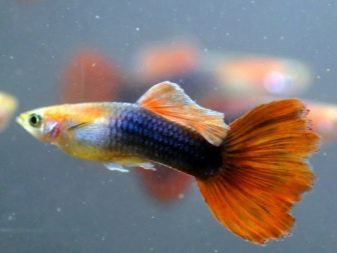
Beautiful examples
Small round tanks with evergreen flora and vibrant aquatic life can be a wonderful decoration for any room. Streamlined forms can be harmoniously fit into any interior, making the nanoaquarium a bright accent.
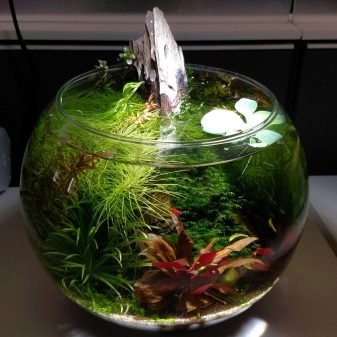

Using for decorating coral "houses" will allow you to turn a small reservoir into real work of artwhere it will be possible to grow attractive aquatic creatures.
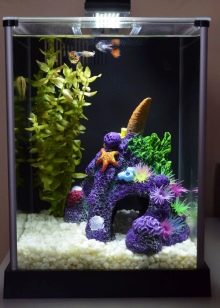


Well-organized lighting will be a real find for those aquarists who want to see unique and mesmerizing underwater landscapes in their homes in the most attractive color.

You will learn how to properly run a nano aquarium from the video below.








